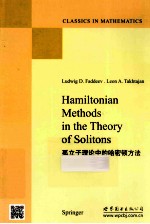图书介绍
孤立子理论中的哈密顿方法 英文PDF|Epub|txt|kindle电子书版本网盘下载

- (俄)雷斯尼克著 著
- 出版社: 北京:世界图书北京出版公司
- ISBN:9787510058264
- 出版时间:2013
- 标注页数:592页
- 文件大小:99MB
- 文件页数:602页
- 主题词:哈密顿原理-研究-英文
PDF下载
下载说明
孤立子理论中的哈密顿方法 英文PDF格式电子书版下载
下载的文件为RAR压缩包。需要使用解压软件进行解压得到PDF格式图书。建议使用BT下载工具Free Download Manager进行下载,简称FDM(免费,没有广告,支持多平台)。本站资源全部打包为BT种子。所以需要使用专业的BT下载软件进行下载。如BitComet qBittorrent uTorrent等BT下载工具。迅雷目前由于本站不是热门资源。不推荐使用!后期资源热门了。安装了迅雷也可以迅雷进行下载!
(文件页数 要大于 标注页数,上中下等多册电子书除外)
注意:本站所有压缩包均有解压码: 点击下载压缩包解压工具
图书目录
Introduction1
References7
Part One.The Nonlinear Schr?dinger Equation(NS Model)9
Chapter Ⅰ.Zero Curvature Representation11
1.Formulation of the NS Model11
2.Zero Curvature Condition20
3.Properties of the Monodromy Matrix in the Quasi-Periodic Case26
4.Local Integrals of the Motion33
5.The Monodromy Matrix in the Rapidly Decreasing Case39
6.Analytic Properties of Transition Coefficients46
7.The Dynamics of Transition Coefficients51
8.The Case of Finite Density.Jost Solutions55
9.The Case of Finite Density.Transition Coefficients62
10.The Case of Finite Density.Time Dynamics and Integrals of the Motion72
11.Notes and References78
References80
Chapter Ⅱ.The Riemann Problem81
1.The Rapidly Decreasing Case.Formulation of the Riemann Problem81
2.The Rapidly Decreasing Case.Analysis of the Riemann Prob-lem89
3.Application of the Inverse Scattering Problem to the NS Model108
4.Relationship Between the Riemann Problem Method and the Gelfand-Levitan-Marchenko Integral Equations Formulation114
5.The Rapidly Decreasing Case.Soliton Solutions126
6.Solution of the Inverse Problem in the Case of Finite Density.The Riemann Problem Method137
7.Solution of the Inverse Problem in the Case of Finite Density.The Gelfand-Levitan-Marchenko Formulation146
8.Soliton Solutions in the Case of Finite Density165
9.Notes and References177
References182
Chapter Ⅲ.The Hamiltonian Formulation186
1.Fundamental Poisson Brackets and the r-Matrix186
2.Poisson Commutativity of the Motion Integrals in the Quasi-Periodic Case194
3.Derivation of the Zero Curvature Representation from the Fun-damental Poisson Brackets199
4.Integrals of the Motion in the Rapidly Decreasing Case and in the Case of Finite Density205
5.The ?-Operator and a Hierarchy of Poisson Structures210
6.Poisson Brackets of Transition Coefficients in the Rapidly Decreasing Case222
7.Action-Angle Variables in the Rapidly Decreasing Case229
8.Soliton Dynamics from the Hamiltonian Point of View241
9.Complete Integrability in the Case of Finite Density249
10.Notes and References267
References274
Part Two.General Theory of Integrable Evolution Equations279
Chapter Ⅰ.Basic Examples and Their General Properties281
1.Formulation of the Basic Continuous Models281
2.Examples of Lattice Models292
3.Zero Curvature Representation as a Method for Constructing Integrable Equations305
4.Gauge Equivalence of the NS Model(x=-1)and the HM Model315
5.Hamiltonian Formulation of the Chiral Field Equations and Related Models321
6.The Riemann Problem as a Method for Constructing Solutions of Integrable Equations333
7.A Scheme for Constructing the General Solution of the Zero Curvature Equation.Concluding Remarks on Integrable Equa-tions339
8.Notes and References345
References350
Chapter Ⅱ.Fundamental Continuous Models356
1.The Auxiliary Linear Problem for the HM Model356
2.The Inverse Problem for the HM Model370
3.Hamiltonian Formulation of the HM Model384
4.The Auxiliary Linear Problem for the SG Model393
5.The Inverse Problem for the SG Model407
6.Hamiltonian Formulation of the SG Model431
7.The SG Model in Light-Cone Coordinates446
8.The Landau-Lifshitz Equation as a Universal Integrable Model with Two-Dimensional Auxiliary Space457
9.Notes and References463
References467
Chapter Ⅲ.Fundamental Models on the Lattice471
1.Complete Integrability of the Toda Model in the Quasi-Peri-odic Case471
2.The Auxiliary Linear Problem for the Toda Model in the Rap-idly Decreasing Case475
3.The Inverse Problem and Soliton Dynamics for the Toda Model in the Rapidly Decreasing Case489
4.Complete Integrability of the Toda Model in the Rapidly Decreasing Case499
5.The Lattice LL Model as a Universal Integrable System with Two-Dimensional Auxiliary Space508
6.Notes and References519
References521
Chapter Ⅳ.Lie-Algebraic Approach to the Classification and Analysis of Integrable Models523
1.Fundamental Poisson Brackets Generated by the Current Alge-bra523
2.Trigonometric and Elliptic r-Matrices and the Related Funda-mental Poisson Brackets533
3.Fundamental Poisson Brackets on the Lattice540
4.Geometric Interpretation of the Zero Curvature Representation and the Riemann Problem Method543
5.The General Scheme as Illustrated with the NS Model558
6.Notes and References566
References573
Conclusion577
List of Symbols579
Index585